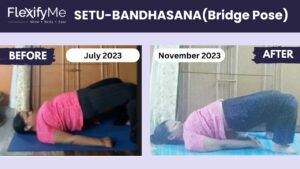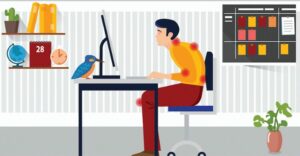Embracing the Ergonomic Shift in Our Daily Grind
Ever found yourself shifting in your chair, trying to dodge that nagging lower back pain after hours of work? That’s your body crying out for ergonomics—a concept that’s swiftly moving from office boardrooms to our home offices and kitchen tables. As the line between ‘work’ and ‘home’ blurs, our need to sculpt our work environments to our bodies’ whims has never been more urgent or personal.
Imagine this: The Pew Research Center recently pointed out a striking trend; a good chunk of us are now setting up shop at home, permanently. This isn’t just a fleeting change; it’s a deep dive into a future where our living spaces double as our workspaces.
So, what’s at stake with this ergonomic evolution? It’s not just about dodging aches and pains. The National Institutes of Health has thrown light on a more alarming picture—how our disregard for ergonomic principles could be setting us up for a tryst with musculoskeletal disorders that could stick with us long term.
Now, picture having the power to mold your workspace like clay, crafting an environment that doesn’t just ‘work’ but sings to your rhythm. It’s about turning a corner of your living room into a haven that aligns with your posture, your mood, and even your work ethos. This isn’t a fleeting trend; it’s about seizing autonomy over how and where you work best, ensuring you’re not just productive but also genuinely at ease.
This ergonomic wave we’re riding? It’s about more than just comfort—it’s about reimagining our work sanctuaries in a way that resonates with our individual needs, quirks, and styles. It’s a narrative that sees us not just as workers, but as individuals who deserve spaces that are as unique and dynamic as we are.
As we lean into this ergonomic transformation, it’s clear that the revolution is deeply personal, reflecting a broader shift towards acknowledging and acting on what we need to be our best, most vibrant selves at work.
Crafting Your Ergonomic Haven: Your Personal Guide
Transforming that corner of your home into a haven that’s just as cozy as your favorite café corner but tailored for your work. Let’s walk through this transformation, making each step feel like a choice for your comfort and health, not just a checklist.
1. The Heart of Your Haven – Adjustable Furniture: Imagine your desk and chair as loyal companions, ready to adapt to your every need. An adjustable desk isn’t merely a surface for your laptop; it’s a dynamic space that rises and falls with your body’s rhythm, letting you alternate between standing and sitting, breaking the monotony. And your chair? Think of it as a supportive friend, always there to offer a comfortable embrace, tailored just for you.
2. Embracing Support – Posture Allies: Introduce lumbar cushions and footrests into your space, not as mere accessories, but as essential partners in your quest for comfort. They’re not just ‘add-ons’; they’re your secret weapons against the fatigue that creeps in after hours of sitting, whispering constant reminders to care for your back and legs.
3. Your Window to the World – Monitor Placement: Positioning your monitor is like hanging a picture frame; it requires thought and a keen eye. It’s not just about technicalities like height and distance; it’s about crafting a visual experience that invites you in, keeps you engaged, and says goodbye to unnecessary strain.
4. Harmony at Your Fingertips – Keyboard Comfort: Your keyboard should feel like an extension of your hands, a place where fingers dance with ease, not strain. Dive into the world of ergonomic keyboards, where each keypress is gentle, each layout intuitive, inviting your hands to a stress-free experience.
5. Setting the Scene – Lighting Mastery: Illuminate your workspace with the same care you’d light your living room for a cozy evening. It’s about balancing natural light with soft, artificial glows, creating an ambiance that keeps your eyes relaxed and your mind focused, mirroring the tranquility of dawn or the calm of dusk.
6. The Finishing Touches – Ergonomic Accents: Round off your haven with wrist rests, anti-fatigue mats, and other ergonomic gems that might seem small but make all the difference. These are the cherries on top, the final flourishes that say, ‘This is a space designed for me.’
By infusing your workspace with these elements, you’re not just following ergonomic principles; you’re setting the stage for days filled with productivity and comfort, crafting a space that’s uniquely yours. It’s a place where work feels less like work and more like engaging in a passion, in an environment that’s just as caring and attentive to your needs as you are to your tasks.
The Power of Collaboration: Communication is Key
Imagine a workspace where every voice matters, where the ergonomic needs and insights of each employee are valued and heard. This is the essence of a collaborative environment, where open communication paves the way for innovative ergonomic solutions and a happier, more engaged workforce.
1. Fostering Open Dialogues: In this era of evolving workspaces, the significance of transparent communication between employees and managers cannot be overstated. Encouraging conversations about ergonomic needs not only illuminates diverse perspectives but also cultivates a culture of care and mutual support. Picture a team meeting where sharing ergonomic tips becomes as commonplace as discussing project milestones, fostering a sense of community and shared purpose.
2. Sharing Best Practices: Imagine a platform within your organization where employees exchange their tried-and-tested ergonomic hacks, from the perfect desk height to the ideal monitor angle. This isn’t just about swapping tips; it’s about building a collective repository of knowledge that benefits everyone, turning individual insights into a shared treasure trove.
3. Utilizing Various Channels: Whether it’s through surveys that dive deep into employees’ ergonomic preferences or suggestion boxes that welcome innovative ideas, the goal is to create multiple avenues for feedback and discussion. Envision a scenario where an employee’s recommendation for a better chair or a more flexible keyboard layout sparks a broader conversation, leading to tangible improvements in the workspace.
4. The Impact of Engagement: Drawing from research, like those conducted by Gallup, it’s clear that open communication is a cornerstone of employee engagement. When employees feel their ergonomic concerns are heard and addressed, it not only boosts their well-being but also their connection to their work and the organization.
5. Collaboration in Action: Consider the success stories highlighted in business publications, where companies have transformed their work environments through employee collaboration, yielding impressive results in productivity and satisfaction. These narratives aren’t just inspiring; they’re practical blueprints for fostering a communicative and collaborative culture.
In fostering a workspace where communication thrives, we unlock the power of collective wisdom. By valuing each employee’s voice and encouraging collaboration, we not only enhance ergonomic well-being but also forge a stronger, more connected team. This isn’t just about creating a comfortable workspace; it’s about building a culture where every individual feels seen, heard, and valued, driving innovation and engagement to new heights.
When Work Adapts to You: A Journey to Well-being
Visualize your workspace not just as a place you go to but as a space that morphs to meet you, where flexibility isn’t a policy—it’s a promise. This vision is about creating environments that echo your work rhythm, catering to your need for change, whether it’s about location or posture.
1. Choosing How You Work Best: Imagine a workspace that doesn’t chain you to a single spot or posture. Whether it’s the freedom to draft a report from your sunny patio or to stand and stretch amid an intense brainstorming session, here, your preference reigns supreme. It’s about acknowledging that your best work doesn’t come from rigidity but from the freedom to choose.
2. Tailor-Made Comfort: Step into an environment where every piece of furniture has a mission: to adapt to you. From desks that rise to greet you to chairs that mold to your form, each element is a testament to a philosophy that prizes your comfort as a catalyst for productivity. It’s about transforming your workspace into a realm where every item is an ally in your quest for well-being.
3. The Tangible Benefits of Ergonomics: Dive deeper into the narrative that ergonomic investments aren’t just beneficial; they’re indispensable. Picture a reality where every dollar spent on making your workday more comfortable multiplies in returns through reduced absenteeism and a vibrant boost in productivity. This isn’t speculative; it’s a proven equation where well-being translates into undeniable value.
4. Cultivating a Caring Culture: Imagine a company that doesn’t just pay lip service to well-being but lives it, embedding flexibility and health into its very fabric. In this culture, ergonomic choices and flexible arrangements are not perks but reflections of a deep-seated belief in valuing and nurturing every team member.
In this envisioned space, your workplace transcends being a mere location and becomes a dynamic partner in your well-being journey. Here, adaptability and care are not just principles but practices, creating an environment where every individual is empowered to thrive, not just as professionals but as people cherished for their unique contributions and needs.
Your Work Spot, Your Way
Think about strolling into your work zone and it just feels right, like your spot. No corporate jargon, no lofty policies, just simple, straight-up you-time at work. It’s about turning that work spot into a little haven of ‘you-ness.’
1. It’s All You: How cool would it be if deciding on your work setup was as easy as choosing your lunch? Want to mix it up and stand while you brainstorm? Or maybe you’re in the mood to catch some natural light by the window? Here, you get to choose, every day, just like your playlist.
2. The Right Kind of Bosses: Imagine having a boss who’s more like a buddy — someone who genuinely wants to see you comfy and happy in your workspace. They’re there to give you the thumbs up, not to hover and nitpick. It’s about having that nod that says, “Go ahead, make it yours.”
3. Happy Space, Happy Face: When you get to arrange your workspace your way, it’s more than just physical comfort; it’s about feeling mentally tuned in and happier. It’s like setting up your personal den — when it feels right, everything just clicks, including your productivity and mood.
4. Here’s a Thought – FlexifyMe: If figuring out the best ergonomic setup has you scratching your head, imagine FlexifyMe stepping in like a knowledgeable friend. They can guide you, offering simple, actionable advice to tweak your workspace so it’s just perfect for you. Think of it as having a buddy who’s all in on making your work life better.
See, making your workspace suit your style shouldn’t be a drag. It’s about little choices that add up to big smiles, making each workday a bit more ‘you.’ And when you feel good in your space, it shows — in your work, your attitude, and even in those little moments of everyday joy.


